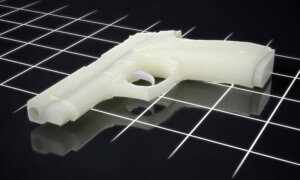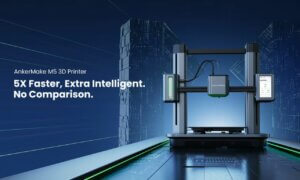3D printing is no longer a luxury. Compared with ten years ago, when a decent 3D printer, with all its limitations, could go upwards to $1000, now you can get the same amount of quality and surface for 3D printing, for a third of that price.
In a decade, 3D printing has found its way into most branches of applied sciences, common households, aerospace, defense, most consumer goods industries, medical, dental, and industrial goods.
You can buy an off the shelf 3D printer and start tinkering with it in a matter of hours. And this is the fun part. As adults, we are like little kids playing with a chemistry set when it comes to a new 3D printer. Any owner can attest to the feeling of getting your first 3D printer, and the level of excitement you get when you think about what kind of cool stuff you can print with your new toy. Any owner of a 3D printer can also attest to the level of disappointment you will get to when you realize that maybe 80% of what you contextualized in your mind’s eye, can’t be printed with your new toy.
So how is 3D printing going to change the world?
Especially if a mid-price-range 3D printer, in 2020, can’t do at least half of the things I propose! To answer that, all we need to do is look back ten years ago, see the prices, see the market back then, and then realize that this is only the consumer side of the 3D printing world.
The consumer side of 3D printing is growing in size and product offerings, and new companies show up with crazy ideas out of the woodwork every day. 3D printing is becoming more and more accessible, and with time, it will find a way to get inside every home. Just the idea of printing your own tools, parts, or complex structures, at home, is exhilarating. With the help of a 3D Printer, you can fashion them yourself, pay some guy in India to make them for you on Fiver, or just buy the schematics from the manufacturer of your choice and print them. The freedom 3D printing will give to the consumer is on par with the replicator from Star Trek. And 3D printing is not SciFi.
Usually, the creation of a 3D printed object is achieved by using additive processes. In this process, an object of your choice is created by laying down successive layers of material until the object is complete. Every one of these layers can be seen as a small horizontal cross-section of the eventual object. Stacking these cross-sections one on top of the other will result in the desired object.
Point is, 3D printing is less wasteful.
In a way since, as of now, there’s no consumer-viable method to recycle used filament, and if something goes wrong in the 3D printing process, all that material goes to waste. So there are some drawbacks when it comes to 3D printing, but notice we said ‘no consumer-viable method’. For a big company, to melt down the material and rethread it is easy. And this is where 3D printing makes the changes and the massive difference. In the Industrial and applied sciences fields. The ones we mentioned at the beginning of the article.
All the cool 3D printing happens in the industrial and applied sciences fields
This is where all the cool kids want to hang out. Mainly because the industrial field comes with very deep pockets to spend on new ways to 3D print stuff, and applied sciences need fast ways to print complex shapes or specific parts. In the aerospace industry, 3D printing was used recently by SpaceX and NASA to print the custom-made spacesuits for the recent ISS flight. They can now print body parts. 3D printing is becoming a new beast entirely, and it’s being used in fields you never thought it could be applicable. Like running shoes.
Companies like Reebok, Adidas, Nike, and Under Armour are mass-producing shoes with 3D printed soles. You might even have a pair of running shoes that have 3D printed soles. The Liquid Floatride Run shoe, made using the technology, is introduced by Reebok. Or maybe the Adidas Futurecraft. Under Armour has its Architech 3D printing tech. These are just a few examples to note the versatility of this technology. And this is only applied to the consumer sector.
One patent expiration date made this possible.
On the industrial level, science and defense, 3D printing is on another level compared with the plastic things we make at home. Sure, 3D printing opens a world of fun, but when applied to real-world problems, it can solve, or at least patch, some of them.
It is too early to stipulate what is to be done with this technology, 3D printing has only debuted on the consumer market, and was made available for the masses after the original patent expired. Now, with more creative people, and more science advances than ever, this can save a lot of lives.
Why don’t we have a medical, 3D printing, TV drama?
I mean, they had a fake disabled American doctor delivering snarky remarks about fake medicine for 8 seasons. Why not a TV drama about the new and exciting world of 3D printing, where a team of students invents a way to print organs and body parts and try to save people with this technology, but nobody believes in them and they lack funds? Like in real life?
Meanwhile, in the real world medical field, 3D printing is on the cutting edge of science. We can now print a human ear that the affected body will not reject. Because the ear we printed, is made with cells from the affected body itself. Lung tissue, bones, arteries, maybe in the future an anatomically correct, flawless human body that we keep for parts. Not now, but in the future, a 3D printed organ will not be so out of the ordinary as we think. Even now, we use 3D printed dentistry and dentists have some interesting 3D printers for recreating human teeth.
Called Dental 3D printers, these machines feature lasers or lights that polymerize liquids or fuse a powder with computer-guided precision. They are capable of producing models, parts, and complete restorations with a range of materials. Dental 3D printers can restore a destroyed jaw bone, missing teeth, or execute bone pieces that the body didn’t develop in the womb. A cleft lip can be solved using a 3D printer, as the device is capable of printing complex shapes, that will fit the missing space, forgot by nature, in the pericranium.
Changing the world takes time, maybe lifetimes.
The more advanced 3D printing gets, the more we can get from it. Sure, it is like the splitting of the atom, some aspects of the technology are dangerous. But it’s all in the way we use it in the future. With time, we will be able to miniaturize the process, introduce more printing heads into the equation, print with more materials, rapidly, and more efficiently.
At this point in time, 3D printing can be an expensive hobby. With all the models on the market, the buyer can find a printer that suits some of his needs. Notice the word ‘some’. Sometimes getting a 3D printer leads you down a money spending rabbit hole. A new frame, new motors, maybe a better 3D printing head, maybe you need a new machine that prints metal or certain polymers. There’s also the cost of the material, the filaments, that adds up. And the time you spend printing the object.
Some fuss has been made over 3D printed guns and weapons. Some of it legitimate, some of it fearmongering. Problem is, right now, for the normal user, it is easier to buy a gun than to 3D print one. Considering the cost of the machine, materials, and the risk of machine-made error, manufacturers of this type of guns can have some nasty surprises in their hands. If something goes wrong in the printing process and the material has some internal structural flaws, the gun is compromised and it can even lead to an explosion.
Also, at this moment, there’s no way to print a viable barrel for a repeat use gun. So mass production of 3D printed guns is out of the question for the time being. Circling back to ‘3D printing can be an expensive hobby’, making a 3D printed gun will require some expertise and materials that cost, plus a lot of time and money. Most of the people that are into some strange or offshoot of 3D printing are the forefathers of this technology. Even if we like it or not.
Even the adult industry helps!
The porn industry has embraced 3D printing. Such a device that can print complex shapes is always of help to the small entrepreneur from the porn industry. To the untrained eye, the printing of anatomically correct, or maybe exaggerated body parts can’t amount to anything. But for medicine, that right now can print ears, bones, and fingers, the printing of anatomically correct, or maybe exaggerated body parts lead to something.
The future is the miniaturization and standardization of 3D printing.
As 3D printing is moving forward with the type of materials, surfaces, and shapes it can print, the miniaturization of the printing head is the next step in the evolution of the 3D printer. Printing shapes at a smaller scale can lead to metamaterials, better semiconductors, who knows, maybe in the future, you can print your PC parts at home. For that to happen, we need more investments in the consumer sector. We absolutely need a 3D printer with more than one printing head, that saves time. The time that is so essential in some fields like medicine, and where a fast printer can make a difference. This means faster 3D Printers, even faster than the 500mm/s that the DeltaWASP 2040 Turbo 2 offers, or the 4000 cm³/hr that the HP MultiJet Fusion proposes.
Standardization is also a huge factor that influences the market. There is no way to quantify the market in some shape or form because manufacturers don’t have a standard way of doing things. Some aspects of 3D Printing should be standardized, starting with filaments, and ending with a comprehensive rating system. A rating system that explains to the potential buyer, in just one pictogram, what the 3D printer can do. So we avoid the ‘at least half of what you imagined can’t be printed’ moment.
Let’s be honest, we don’t have the iPhone of 3D printers. At least right now. Some amazing piece of engineering that is so simple and so effective in what it does. And let’s not forget, 3D printers don’t have a killer app yet. The focus right now should be standardization, a killer app, and miniaturization. But first, the manufacturers need to sit down at a round table and discuss where they want to invest and what they want to invest in. As things stand right now, with the market so segmented and fractured, most commercial 3D printing companies are barely afloat. Nonetheless, a talk between manufacturers of 3D printers would help consumers in the end, and maybe advance the tech.
Follow TechTheLead on Google News to get the news first.























